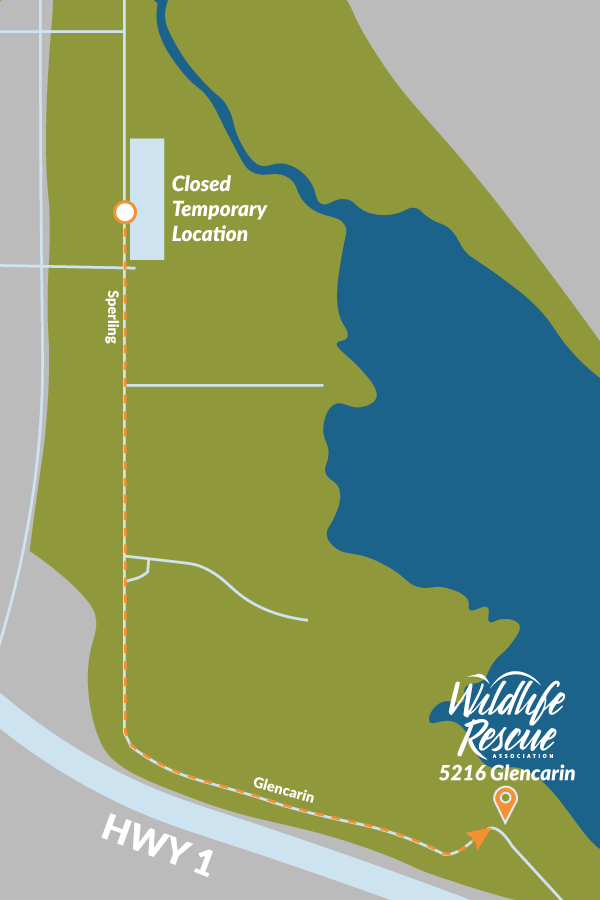Support Us
Since 1979 more than 140,000 animals have been treated by Wildlife Rescue.
Thanks to the support of individuals like you, Wildlife Rescue can provide a lifeline for animals in distress.
Watching an animal arrive at the Wildlife Hospital in critical condition, recover, and return to the wild is one of the most rewarding parts of wildlife rehabilitation. Occasionally, we’re treated to something even more special: hearing that a past patient is not just surviving but thriving, even decades later!
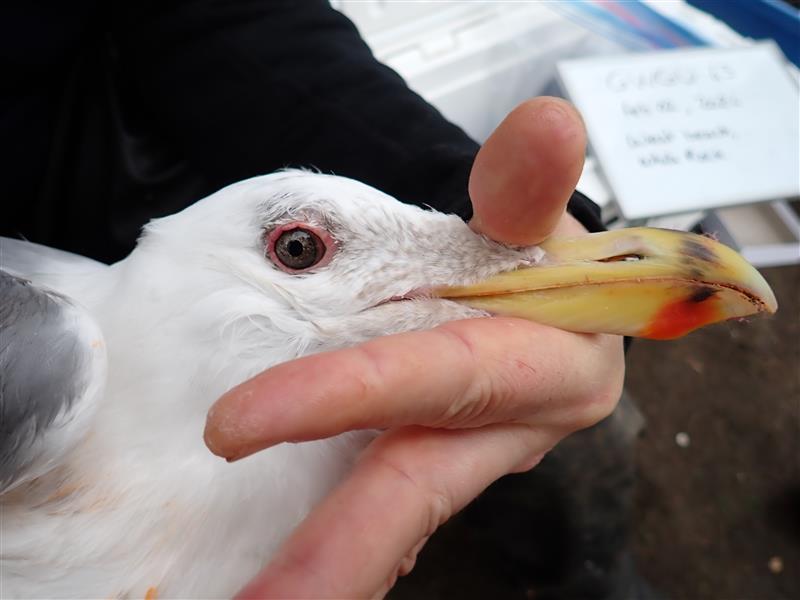
In August of the year 2000, a young Glaucous-winged Gull was found orphaned in Vancouver and brought to Wildlife Rescue by a worried wildlife friend. Thanks to the community’s support, the gull received a second chance and was raised at the Wildlife Hospital. The bird learned how to swim and forage, and received expert care to grow into a healthy, strong juvenile. After a month in care, the gull had developed all the critical skills needed to survive in the wild.
Just prior to being successfully released at Belcarra’s shoreline, the bird was banded by Master Bander Liz Thunstrom. The purpose of banding is to gain knowledge about the survival rate of birds treated in care after being released into their natural habitats. It helps researchers understand how well orphaned birds raised in captivity adapt to life in the wild, and how those that have recovered from ailments go on to succeed in the wild.
Fast forward to February 2024: the now mature gull was recaptured in White Rock by researchers from Environment and Climate Change Canada (ECCC) as part of their Salish Sea Gull Project.* The bird was fitted with several new coloured bands to make them easily identifiable from a distance and was spotted in White Rock again in September.
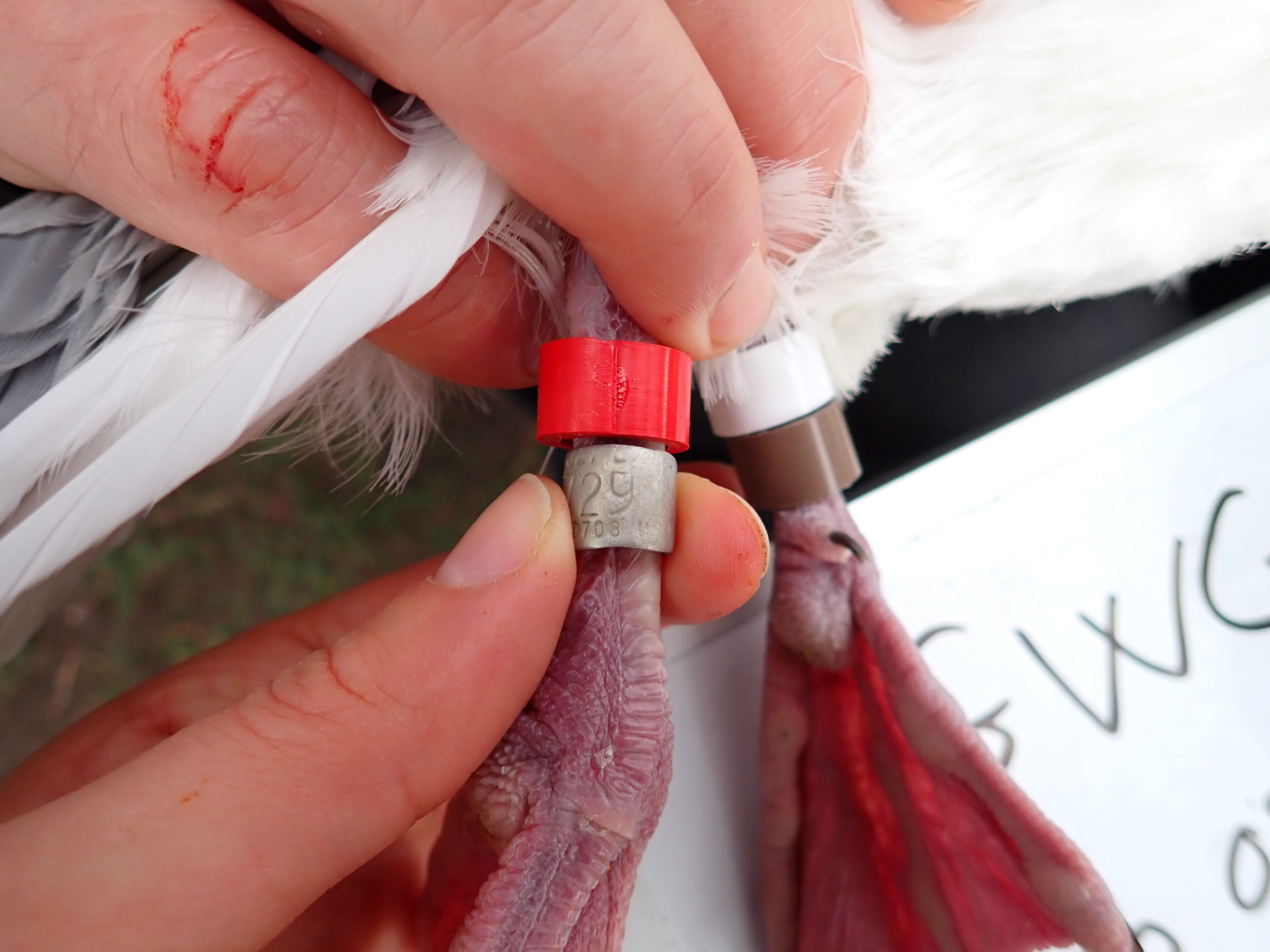
“I was very surprised and pleased to hear of this recapture report after 24 years! This more than exceeded my hopes for its future when the bird was originally released back into the wild after banding,” said Thunstrom. “It would be interesting to know what experiences the bird had in those years and how many young it produced in that time, but most satisfying is that it survived and did so well!”
The Salish Sea Gull Project is an integral part of the Salish Sea Marine Bird Monitoring and Conservation Program. This five-year initiative is especially significant as gull species are protected under the Migratory Birds Convention Act of 1994 and have been identified as a stewardship priority by ECCC.
“[We are] conducting research on Glaucous-winged Gulls as indicators of the health of the Salish Sea, the idea being that if the ocean is healthy, the birds will be healthy,” said Dr. Mark Hipfner, ECCC Research Scientist. “As part of the larger project, we are banding gulls with unique combinations of colour bands to quantify age-specific survival rates. This individual confirms for us that these gulls can live good, long lives.”
Have you seen a banded gull? Your sighting could help conservation efforts! Report colour-banded gulls to the Salish Sea Gull Project and contribute to ongoing research.
Learn how to report sightings here.
*This research project was conducted under the appropriate permits.
If you are trying to reach our facility, we recommend planning your route in advance. The Highway 1-Kensington Avenue Interchange westbound off-ramp is closed July 2-August 31, 2025. The City of Burnaby’s recommendation for alternate routes is Gaglardi Way or Willingdon Avenue for north/south travel off Highway 1 westbound.

Please see this link from the City of Burnaby for the most up to date information here.
Thank You!
Father’s Day is an important celebration for many of us. It is an opportunity to reflect and honour the special bonds we have with our fathers and father figures in our lives.
With this special day around the corner, I would like to share a very early memory of my father. He profoundly influenced my passion for wildlife from a very young age, and so today, I’m sharing this memory with you. I hope you enjoy…
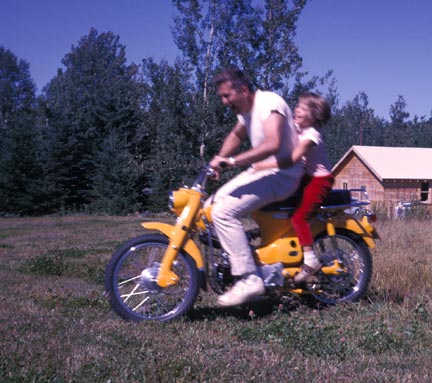
My father taught me a love for wildlife that grew into my lifelong purpose. I grew up in rural Maine surrounded by nature and animals. When I was a young girl, my favorite books were about animals. One book I loved was Bambi. So, when I heard that my dad and uncle had two deer in the garage, I was very excited to go see them, expecting Bambi. What I found were two deer that had been taken during hunting season to provide food for our families through the winter. I was about 5 years old, and the shock was huge for me. I cried uncontrollably, repeating over and over that “dad killed Bambi”.
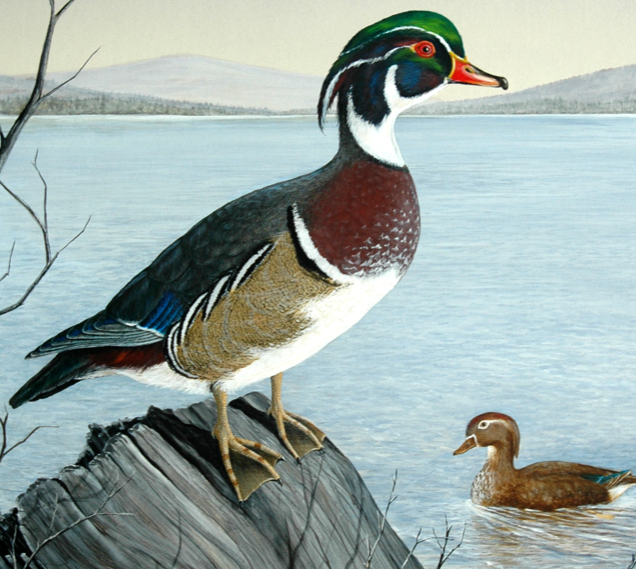
My reaction had an intense impact on my father, who never took the life of another animal again. He put down his rifle and picked up his camera, pen, and ink. My dad was an amazing wildlife artist, and I have had the pleasure of spending time with him photographing animals and many hours watching him recreate their beauty on paper and canvas. During my teenage and early adult years, my dad began carving and sculpting. As he was a detailed artist, you can see every feather on a bird in his carvings. He generally carved nature scenes, such as a loon chasing a fish underwater.
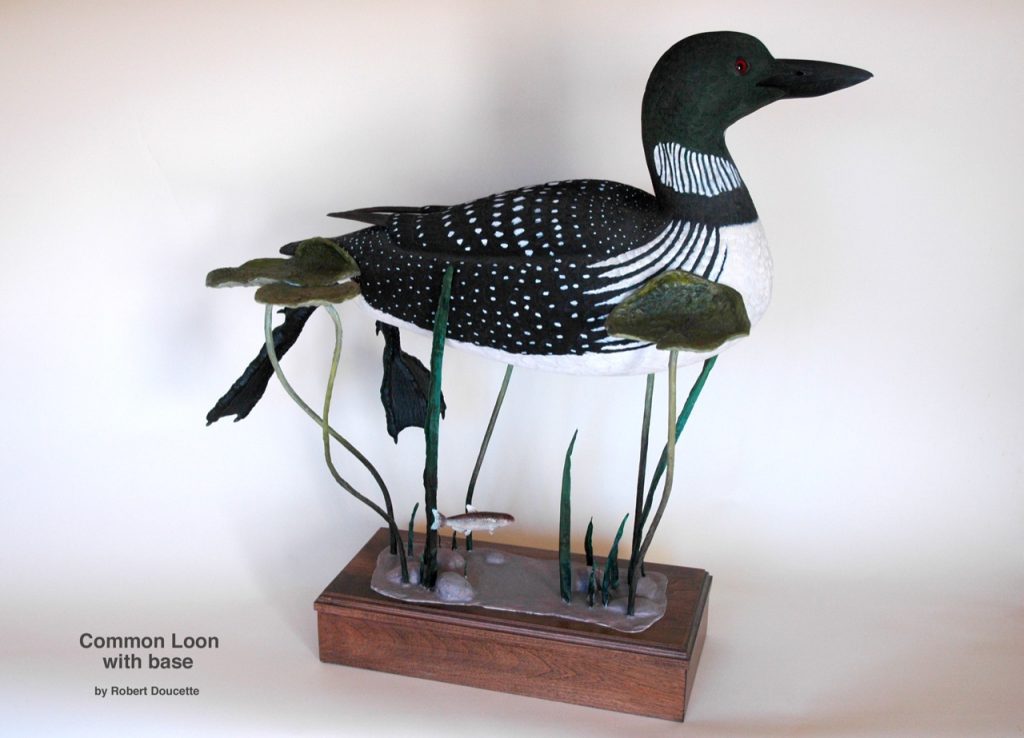
My first career led me to managing a beautiful gift shop in Acadia National Park where I carried many local artists, including my dad’s work. It was an honor to share his talents with the world. During my time in Acadia, I encountered a family of beavers that had many challenges because of human disturbance. Somehow, the kits lost their parents and I found out that the state highway authority had plans to rip out the lodge with these young, helpless beavers still in it! So, when the equipment showed up to do the job, they found me sitting on top of the lodge with the local newspaper in tow. I had the National Park Service on my side by then, so the State backed down.
That was the beginning of my wildlife rehabilitation career as I researched how to care for orphaned beaver kits! For a while I considered flooding the basement of my house. My husband was very pleased when the plan changed to working with a national park biologist to live-trap and relocate the young with their older siblings to safety. I still get reports from the biologist on the generations of offspring from this family every once in a while.
Sharing my father’s passion for wildlife led me to intercede on the beaver kits’ behalf which changed my life forever. I am forever grateful to have been taught to love and respect animals from a very young age. HAPPY FATHER’S DAY EVERYONE!
Please donate to help wildlife today.
With warmest gratitude,
Coleen Doucette
Co-Executive Director
Do you know you can set aside money for charity as part of your Will? You may have heard this called planned or legacy giving. And you’ll probably hear a lot more about it in the coming years: a Will Power study found a significant increase (5% to 8%) in Canadians donating to charity in their Wills.

That’s 1.2 million more Canadians giving in their Wills, creating roughly $37 billion in future charitable donations!
Think about how much good $37 billion could do – acres of forest saved, diseases eradicated, many people lifted out of poverty…
And countless wild animal lives saved and returned to their natural habitat.
One apparent reason is the economy forcing us all to hold our wallets a little (or a lot) tighter. Donating in your Will lets you make a significant difference without using the money you need now. Even leaving 1% of your estate to charity in your Will could make a substantial impact.

Coupled with an urgency to do something in the face of growing global need, gifts in Wills have become a popular solution. Inflation and cost of living may have put pressure on Canadian incomes, but the desire to help has never been stronger. This is a way for people to drive the kind of change they want, and it’s well within their reach.
Another reason is demographics. Canadians will pass down roughly a trillion dollars over the next 10 years, the biggest wealth transfer in history. It’s given many of us pause, realizing we probably will have enough to support family and a charity in our Wills.
Lastly, Canadians are just getting more creative with their giving by harnessing the power of Wills, RRSPs and other assets to give more strategically.
It might sound funny to think of your Will as a powerful tool for change in this world, but when it comes down to it, there are many benefits to donating this way:
Contribute more than you could otherwise.
Our donors are always amazed when we tell them how far their donations stretch and how much more we can do for BC’s wildlife with every extra dollar.
When we show them what a small percentage in their Will to Wildlife Rescue could look like, they do the math, and their eyes light up.
Remember that the value of your “estate” is the sum of any property and/or business you own, your pension and/or registered funds, securities like stocks or mutual funds, cash savings, and life insurance. It adds up, even if you subtract debt.
The average Canadian family in 2023 had a net worth of $981,816. If you put just 1% of that aside for charity, you could donate about $10,000 to your favourite cause! When else could the average Canadian make such an extraordinary impact?
Keep your memory alive in a unique way.
Talk about motivation – imagine the pride your children or grandchildren will feel knowing that you’ve contributed to providing the highest standard of care for sick or injured wildlife for generations to come. Or the honour it would be for them to be involved in giving orphaned or pollution-damaged wildlife a second chance to live a natural life.
When your loved ones have something positive and meaningful to associate with your memory, you will have created a legacy that future generations can rally around.
Tax breaks. Big ones.
Canada has some of the most generous charitable tax incentives in the world! In Canada, when you donate, you get a charitable tax credit, which can go a long way toward helping you pay down what you owe.
Your loved ones might need that charitable tax credit upon your passing because your estate will likely be taxed, and they will have to pay the bill. You can even structure your donation differently to get the biggest tax break possible.

A popular approach is to name a charity as a beneficiary of your RRSP (Quebec residents must name beneficiaries of their RRSP in their Will). The credit received will close to cancel out the taxes owed on this asset.
If you’re interested in learning more, you can always book a consultation with a financial advisor specializing in charitable giving.
It’s easier than you think!

Most donors have follow-up questions when they learn about the option to leave a portion of their Will to charity.
What about my family? I want to leave everything to them.
It’s possible to support both family and charity in your Will. Think about your Will in terms of percentages. If you set aside even 1% in your Will for charity, you can make a lasting difference (and lower taxes owed). And you’re still leaving 99% to support loved ones. It’s a win-win.
I don’t have much to give.
You might have more than you think. For example, donors are often surprised to hear that the RRSP or life insurance policy they have through work can be a smart way to give.
It’s worth taking stock of your assets. Even a modest amount can make a sizeable impact.
Do I have to be wealthy to leave a gift in my Will?
Not at all! Middle-income Canadians typically give this way. Do you know that the average donation made in a Will from the average Canadian is around $35,000? That’s the power of gifts in Wills!
How will I know what my gift accomplishes?
You won’t be able to see your gift in action, but when you leave a donation to Wildlife Rescue in your Will, you and your family become part of our Wildlife Community. We would love to hear how your vision matches our mission to save BC’s wildlife.
What if I change my mind?
Remember, you can always make changes to your Will. People generally update their Will at least a couple of times in their life.
You might also consider tools outside your Will to make a legacy gift. For instance, you can name a charity as a beneficiary of your RRSP or life insurance policy and make changes at any time. No hassle, no fuss.
Am I too young to be thinking about this?
If you have any assets, you’re not too young to be thinking about what happens to them. Without a Will, an executor or administrator will settle your estate according to provincial or territorial laws, which might not coincide with your values and wishes.
Everyone can leave a charitable gift from their estate, regardless of size. Your legacy reflects your life. It’s about the person you are, the values you demonstrate, and the example you want to set for others.

If you have any questions, Sheila, WRA’s Gift Planning Specialist, is happy to discuss more details with you. You can reach her at s.dickinson@wildliferescue.ca or 604-545-1421.
*Consult your financial advisor to ensure the gift aligns with your personal estate plan.
The Will Power campaign
Wildlife Rescue is a partner in Will Power, a national awareness campaign that encourages Canadians to use their Wills as a force for good. Together with Will Power, we want to connect people like you with resources to make the best decisions for their families, their future finances, and the causes that matter to them.
As the crisp air of fall sets in, many of us enjoy the vibrant colors and the cooler temperatures. However, for our feathered friends embarking on their journey south, this season poses significant risks.
Fall migration has started and the Wildlife Hospital has already seen a steep increase in birds admitted for window strike treatment in August and September. This uptick highlights the dangers migrating birds face as they navigate urban landscapes.
During migration, birds often travel at night and may be disoriented by city lights and reflective surfaces. Glass windows and railings, which can appear invisible to birds, present a deadly hazard. With their large windows and glass balcony railings, high-rise buildings are especially dangerous for migrating birds.

Window collisions are a leading cause of death for migratory and resident birds across the world. The stark reality is that these bird-glass collisions result in the death of approximately 25 million birds annually in Canada, a statistic reported by Global Bird Rescue.
Birds that have impacted a window often suffer from concussions, internal injuries, eye injuries, and fractured bones. Even if a bird seems to recover from an initial window strike, injuries can develop or worsen up to 48 hours later. This delayed effect makes immediate care from a trained wildlife rehabilitator critical for the survival of these birds.
There are several proactive measures you can take to help reduce window strikes and safeguard migrating birds:

If you encounter a bird that has collided with a window, it is important to seek help from a trained wildlife rehabilitator immediately. Contact the Wildlife Rescue Support Centre for assistance at wildliferescue.ca/report-an-emergency.
This year, Wildlife Rescue celebrates its 45th anniversary, marking decades of dedicated care thanks to the support of our incredible Wildlife Community. Your generosity today will support our vital work and help window strike victims recover. You can donate here.
By taking these steps, we can all contribute to creating a safer environment for our migrating avian neighbours. Let’s work together to ensure that every bird has a safe journey this fall!

In honour of back-to-school season Wildlife Rescue is launching a colouring campaign!
Below you will find three different bird colouring pages. Get the wildlife lovers in your life to colour their favourite bird and post a photo of the creation on social media. Be sure to tag Wildlife Rescue for the chance to be featured online!
Download the templates here.
You can find all of our social media channels here:
This initiative isn’t just for kids, feel free to share these templates with any colouring enthusiasts you know! If you don’t have social media, you can submit your work to giving@wildliferescue.ca
Wildlife Rescue is featured in the BBC Discover Wildlife Spring 2024 issue. The article gave an inside look into the Wildlife Hospital. Subscribe to the magazine here.
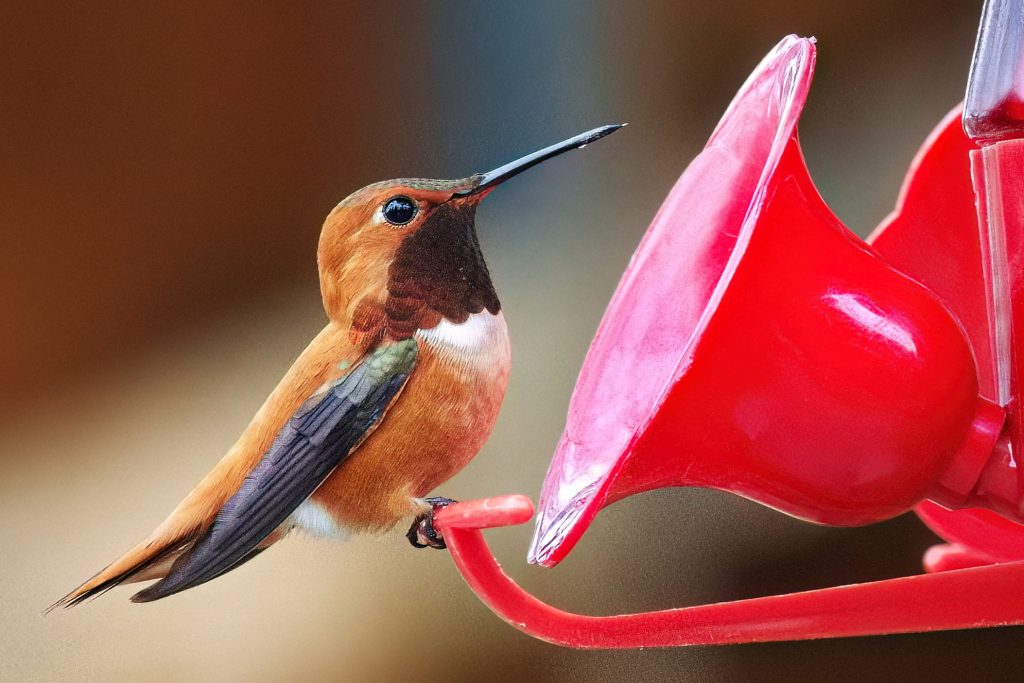
Hundreds of injured and orphaned wildlife patients arrive at Wildlife Rescue due to window and car strikes, nest disturbances, and natural and human disturbances.
Below is your step-by-step guide that takes you through the process of dropping off rescued animals.
Our 2023 Calendar is full of inspiring photos of species of concern in Wildlife Rescue’s care. Each month gives you a small glimpse of the day-to-day care Wildlife Rescue provides for animals in need. Not only that, you’ll also get informative facts and conservation status information.
With 13-months of beautiful wildlife photography, this calendar will look great on your wall, and makes an excellent gift for friends and family alike this holiday season. Best of all, each calendar sold will support the rescue and rehabilitation of thousands of wild animals in the coming year!
Act now, because we sell out of calendars every year! Don’t miss out on this limited edition piece of Wildlife Rescue Association history.
After a successful summer, we are happy to announce that Wildlife Rescue’s Summer Admissions Centre has now closed. Admissions has returned to our Main Site at 5216 Glencarin Drive.
We would like to thank our community members for their unwavering support during this disruption to our regular service. We were pleased to connect with more people than ever at our temporary location, with nearly 1,000 patients admitted through the centre during operations.
We would like to thank FortisBC and Kiewit Corporation for their partnership during the Patullo Gas Line replacement project. Thanks to their help, our Temporary Admissions Centre was made possible.
If you have found an animal in distress, we are happy to assist you at our Main Site at 5216 Glencarin Drive. Please contact our Support Centre for assistance before traveling with the animal.
